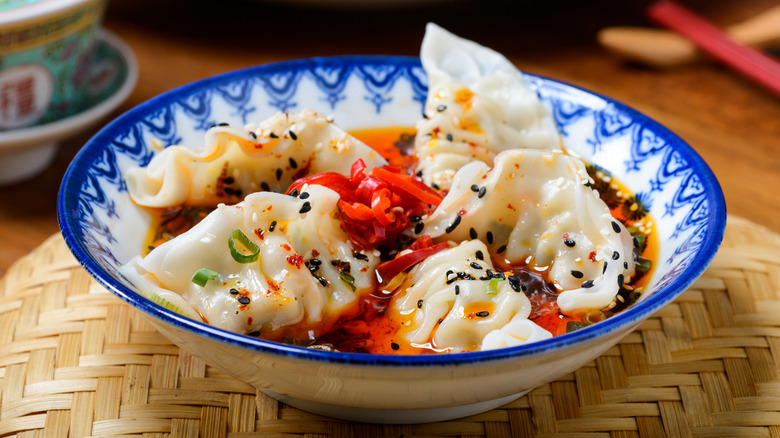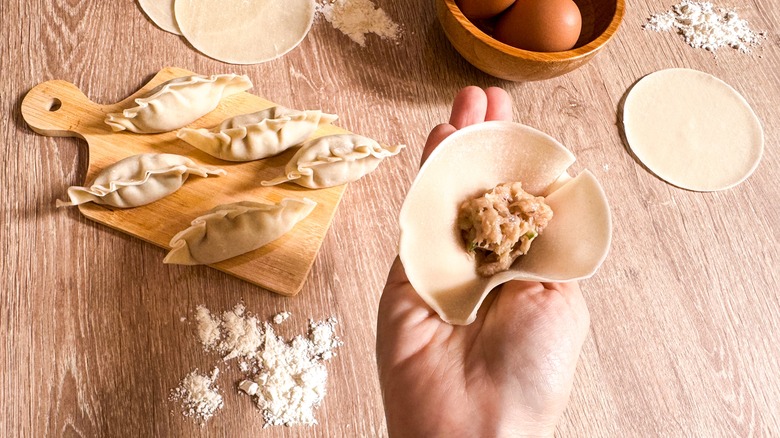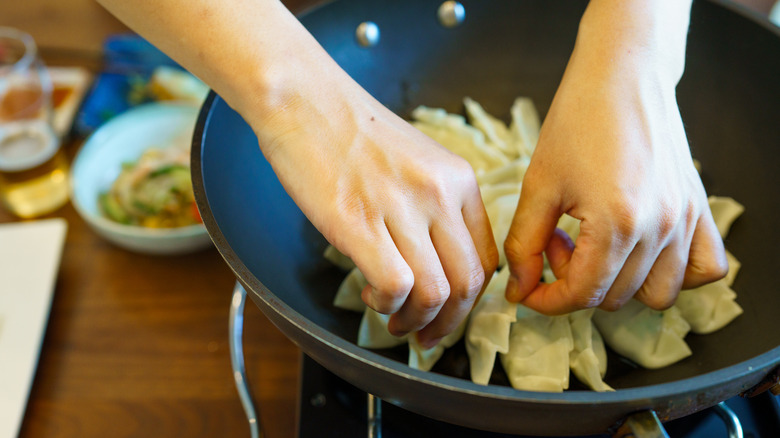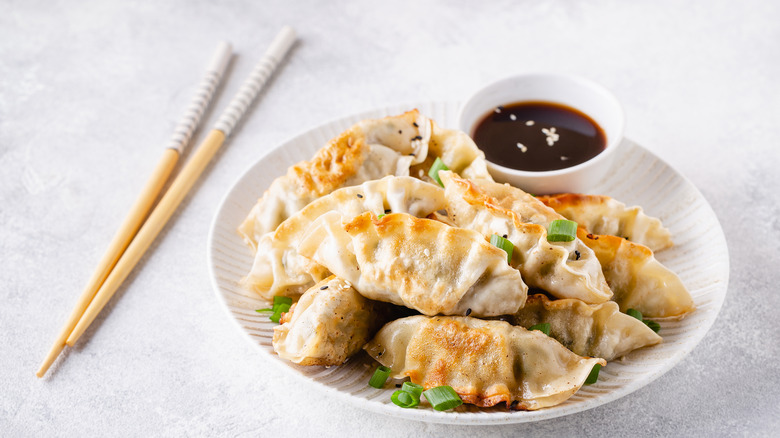A Pro's Advice For Making Unforgettable Pork And Cabbage Jiaozi
There is something so satisfying about downing a half-dozen Chinese jiaozi, or potstickers, from a well-planned dim sum cart or dedicated dumpling stand. The little wheat flour packets, stuffed with pork, cabbage, and other fillings, and fried, steamed, or boiled, provide a burst of savory comfort in each bite. Even better, they're easy to make at home. It can be a challenge to get them just right, though. Among other pitfalls, it's common for homemade jiaozi to burst and leak, or to taste a bit uninspired compared with restaurant versions.
Fortunately, there are a few helpful tips and tricks to up your dumpling game. Chowhound turned to Hutong New York's executive chef Ken Lin for expert advice on making the best possible pork-and-cabbage jiaozi possible. The elegant Upper East Side restaurant, evoking early 20th century Shanghai, specializes in northern Chinese cuisine, which is where jiaozi are said to have originated almost 2,000 years ago. While some people may be more familiar with soup dumplings, wontons or gyoza, the Japanese cousin of jiaozi, these dumplings hold special significance during Chinese New Year celebrations.
Build jiaozi to stay sealed
One of the challenges for new dumpling makers is learning the tricks to keep your dough from cracking, tearing, or falling apart during the building and cooking process, and each style is a bit different. One distinction between gyoza and jiaozi, for example, is the wrapper thickness. Both use unleavened wheat flour wrappers, but those for gyoza are paper thin. They tend to tear but crimp easily and stick together well.
Jiaozi wrappers are a little thicker (you can find them pre-made at Asian grocery stores, or make your own). They can be handled a little more vigorously, but getting the sides to stay pressed together can be a challenge. You don't want the dumplings to come apart while cooking them. The first trick is to not overstuff them with filling. Proper crimping is also helpful (there are a bunch of YouTube videos to guide you). But wetting the edges of the dough is a pro tip worth learning.
"Seal jiaozi edges with a dab of water, pressing firmly," says Chef Ken Lin. The easiest way, especially when making a large batch, is to have a small dish with cool water next to where you're building your dumplings. Add the filling, then dip your fingertip in water (or use the corner of a towel), and run it along the whole rim of the dumpling. They don't need to be dripping wet. Think of it like licking an envelope.
Don't be afraid to go off menu
A filling of pork, ginger, scallion, and chopped or minced cabbage, with a little soy sauce and oil, is a classic one for jiaozi. But after downing two or three batches you may be ready for some variation. You don't have to get as elaborate as they do at Lin's restaurant–where dumplings may contain caviar, squid ink, or truffled shiitake mushrooms–but there's definitely plenty of room for experimentation aimed at boosting the flavors.
"A hint of black garlic or shiso leaf enhances the filling with umami and herbal notes," says Chef Ken Lin, "aligning with Hutong's sophisticated flavors." Or consider switching pork out for shrimp, duck, or lobster. The possibilities are many!
And while you can opt to just pan-fry or just steam the dumplings, Lin suggests a bit of both will enhance the experience. "A light pan-sear before steaming adds a crispy exterior to the tender interior," he says. If you build your dumplings with flat bottoms, they can sit in a bit of oil to pan sear. Then add a little water and cover till the water cooks off.
Add a tasty dipping sauce
Jiaozi are generally accompanied by a dipping sauce. This can be as simple as soy sauce or delicious chili crisp oil, or much more complex. The more ingredients you add (often three or four different sauces and liquids will be combined), the more complex and delectable it gets. You're not simply pouring ketchup on a hot dog: Dipping sauce is designed to complement the already complex flavor profile of the dumpling. So, just like the ingredients of the jiaozi, you're looking for a mix of sweet, savory, salty, umami, and a hint of spice. You could buy one, like Ajinomoto's gyoza dipping sauce, or make your own.
"Create a balanced sauce by combining soy sauce, aged black vinegar, sesame oil, and honey, with fresh ginger or chili for extra depth," Chef Ken Lin says. He explains that a sauce like this "captures Hutong New York's signature touch, blending authentic techniques with refined twists for a memorable at-home dim sum brunch experience."



